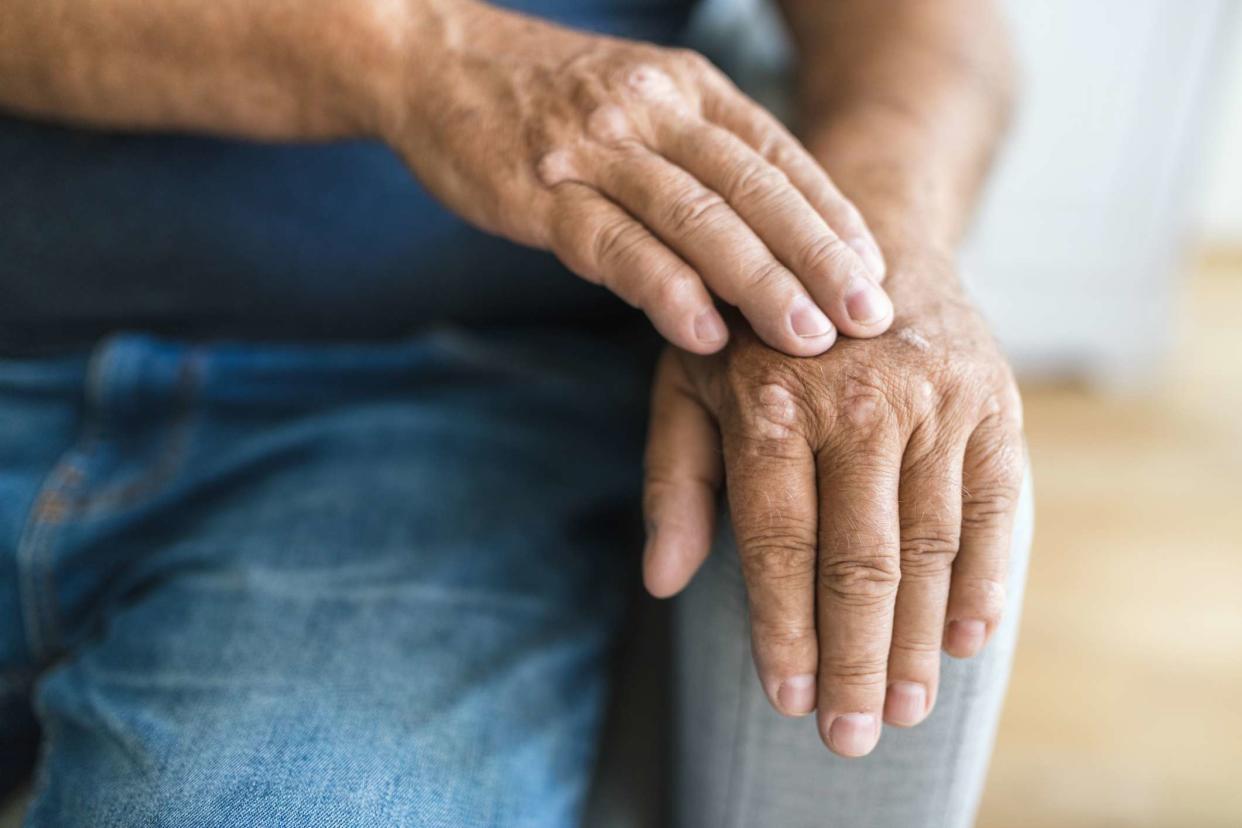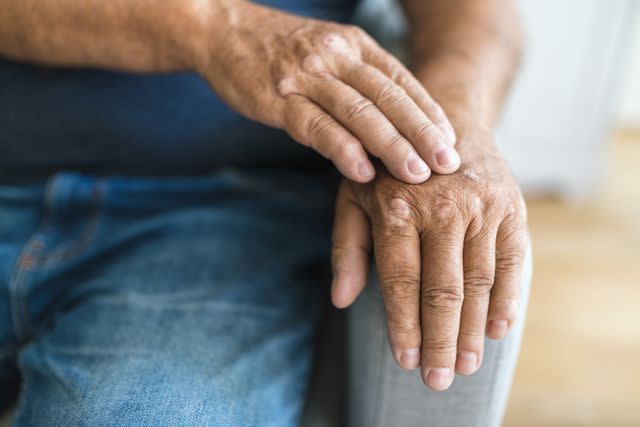What Is Mild Psoriasis?

AND-ONE / Getty Images
Medically reviewed by William Truswell, MD
Psoriasis can be mild, moderate, or severe. Mild psoriasis means the disease affects less than 3% of the body. It is also considered mild if treatments control the disease well and it has little effect on your quality of life.
This autoimmune skin condition occurs when the immune system malfunctions and attacks healthy tissues, leading to skin cell overgrowth. There are different types of psoriasis, each varying in severity, the body areas affected, and appearance. Fortunately, the condition is manageable and treatable.
This article will cover mild psoriasis symptoms and types, how severity is measured, treatment, and more.

AND-ONE / Getty Images
Symptoms of Mild Psoriasis
Symptoms of psoriasis can differ depending on the type of psoriasis you have.
Common symptoms of psoriasis include:
Itchy skin
Burning, sore, and painful skin areas
Patches of thick skin with scales
Small scaly area
Swollen and skin joints
Symptom intensity can distinguish mild psoriasis from moderate or severe disease. For example, psoriasis may be considered severe if plaques (areas of thick skin) are very thick, red, scaly, or itchy, the skin peels, inflamed skin is extremely painful, or there is a significant effect on your quality of life.
Types of Mild Psoriasis
Some types of psoriasis can present milder than others. These include scalp psoriasis, plaque psoriasis, facial psoriasis, and guttate psoriasis.
Mild Scalp Psoriasis
Scalp psoriasis is mild when it appears as fine scaling. Severe scalp psoriasis tends to be thick with crusted plaques that cover large areas of the scalp.
Scalp psoriasis, even when mild, can extend beyond the hairline to the forehead, back of the neck, and around the ears. It might be mistaken for seborrheic dermatitis, another skin condition that affects the scalp and might present similarly.
Mild Plaque Psoriasis
Plaque psoriasis is the most common form of psoriasis. It causes skin cells to build up, creating plaques. Plaques may have white or silver-colored scales on lighter skin. On darker skin, they may appear as purple patches with gray-colored scales.
Most people with plaque psoriasis experience it as a mild to moderate condition. Mild plaque psoriasis will cover less than 3% of the body, while moderate covers 3% to 10%.
For some, plaque psoriasis can present as a severe disease that affects more than just large skin areas. It might affect other body areas and lead to psoriatic arthritis (PsA), which primarily affects the joints. Like psoriasis, PsA is a systemic (whole-body) disease that can affect multiple body areas, including your skin and organs.
Mild Psoriasis on the Face
Around 50% of people with psoriasis will have it on their face. Facial psoriasis will occur on the eyebrows, the skin between the nose and upper lip, the forehead, and the hairline.
The research on facial psoriasis shows the condition tends to be mild. Even so, treating skin lesions on the face is challenging. Also, because a psoriatic rash on the face is hard to hide, it can affect your quality of life due to discomfort and stigma.
Guttate Psoriasis
Guttate psoriasis causes red, purple, or dark spots on the skin, but these spots are not as thick as the ones seen in plaque psoriasis. Guttate psoriasis occurs in children or young adults after an infection.
This type of psoriasis is typically benign (harmless) and clears within three or four months, but its long-term prognosis is unknown. Around one-third of the children who get it will develop plaque psoriasis later in life.
Related:Common Signs and Symptoms of Psoriasis
How Is Psoriasis Severity Measured?
Psoriasis is usually measured on a scale of mild to severe. There is no exact measure for disease severity. Healthcare providers and researchers will rely on different tools. The most commonly used tools are body surface area (BSA), Psoriasis Area and Severity Index (PASI), Physician Global Assessment (PGA), and Dermatology Life Quality Index (DLQI).
Body Surface Area (BSA)
BSA measures the total body area affected by psoriasis. This assessment is typically made visually by a healthcare provider. It can help determine severity when used along with other measuring tools. The BSA reporting method is unsuitable as a sole measure of disease severity and does not measure lesion quality or structure.
Related:Extensor Surfaces: Location and Common Skin Conditions
Psoriasis Area and Severity Index (PASI)
The PASI is the most commonly used tool for determining psoriasis severity. It is often used in clinical studies to determine medication effectiveness. It measures BSA, the extent of raised skin patches, and how hard and scaly plaques are.
PASI scores are from 0 to 72. A score of 4 or lower represents mild disease, while moderate disease ranges from 5 to 10, and severe disease is anything over 10.
Physician Global Assessment (PGA)
With the PGA, a healthcare provider will evaluate your lesions—how red and thick they are and how much scaling there is. They will also use this tool to help them decide if your treatments are working.
PGA uses a global assessment for all lesions on a scale of 0 to 5, with 0 representing clear skin, 1 as almost clear, and so on, ending with 5 as the most severe.
Dermatology Life Quality Index (DLQI)
The DLQI uses 10 questions to assess psoriatic skin's impact on quality of life and daily activities. Scores range from 0 to 30, with the higher scores indicating a more significant impairment in quality of life.
Related:The Severity of Your Psoriasis
Is Psoriasis Dangerous?
Psoriasis can either be mild, moderate, or severe. As long as it is treated and managed, it is not dangerous. But it is also a whole-body disease, which affects multiple body systems and can lead to serious complications, including psoriatic arthritis, inflammatory bowel disease, diabetes, heart disease, metabolic syndrome (a group of conditions that combined increase your risk of heart disease, stroke, and type 2 diabetes), and depression.
In addition, some types of psoriasis (i.e., erythrodermic psoriasis and pustular psoriasis) are more dangerous than others and can be life-threatening if not adequately treated. Both erythrodermic psoriasis and pustular psoriasis require immediate medical attention and hospitalization.
Related:Comorbidities in Psoriasis
Treatment for Mild Psoriasis
If your psoriasis is mild, your healthcare provider will recommend over-the-counter (OTC) remedies, topical medicines (used on the skin), light therapy, and sometimes oral or injectable medicines.
Your healthcare provider will decide which treatments might best help based on the psoriasis type, how much of your skin is affected, the impact on your life, and your overall health.
Over-the-Counter Remedies
OTC remedies for psoriasis might help you better manage psoriasis. Before trying natural remedies, check with your healthcare provider to see if they are safe and won't interact with any medications you take. It is always wise to be mindful that what may work for someone else may not help you.
Some people with psoriasis may benefit from dietary supplements. According to the National Psoriasis Foundation (NPF), fish oil, vitamin D, milk thistle, aloe vera, Oregon grape, and evening primrose oil have been found to ease mild psoriasis. You might also consider aloe vera lotion or oil to manage red and irritated skin.
Soaking in a bath with Epsom salts, olive oil, or mineral oil might soothe skin and reduce scales and plaques. Oatmeal baths might also help soothe irritated skin.
A healthy lifestyle is another way to reduce psoriasis's effects and help you cope better with the condition. This includes eating healthy, staying active, reducing stress, and not smoking or drinking alcohol.
Topical Solutions
Your healthcare provider will start you on the mildest topical treatments for managing skin symptoms. Many are available over the counter, while others require a prescription.
Topical treatments used to treat mild psoriasis include:
Corticosteroid creams to slow down skin cell production and reduce inflammation
Vitamin D analogues to slow skin cell growth
Retinoids to reduce skin cell production and inflammation
Anthralin to slow down skin cell growth
Salicylic acid, available in gels, lotions, and shampoos, to lift and remove scales
Coal tar, available in shampoos, creams, and lotions, to slow skin cell growth and reduce swelling and scaling
You should discuss your use of topical medicines with your healthcare provider, including OTC ones.
Medications and Other Treatments
Your healthcare provider might recommend light therapy or oral and injected medicines to help you better manage the effects of psoriasis on your skin and overall health.
Light therapy (phototherapy) involves exposing the skin to controlled amounts of ultraviolet (UV) light to reduce inflammation and slow skin cell production. Light therapy treatments need to be done consistently and under a healthcare provider's care.
Psoriasis results from a problem with your immune system, which means you may not be able to achieve clear skin with topical therapy alone. Medicines used to treat psoriasis work by affecting the whole body and include biologics (injected or given intravenously, through an IV), oral corticosteroids, and the oral disease-modifying antirheumatic drug (DMARD) methotrexate and cyclosporine.
When to Seek Medical Care for Mild Psoriasis
If you suspect you have psoriasis, you should seek medical attention. This is especially important if other family members have psoriasis, psoriatic arthritis, or other autoimmune diseases.
If you have already been diagnosed with psoriasis, you should reach out if:
Skin symptoms become more widespread, affect additional body areas, or because severe or painful.
You have joint pain.
You are concerned about the appearance of your skin.
Symptoms don't improve despite treatment.
Summary
Psoriasis is an autoimmune skin condition that is classified as mild, moderate, or severe. Severity status is crucial because it helps your healthcare provider better determine your treatment needs.
There are different types of psoriasis, with some presenting milder than others. Plaque, scalp, facial, and guttate types often present more mildly but can be severe or indicate severe disease in some instances.
Disease severity is measured using different scales, including BSA, PASI, PGA, and DLQI. BSA is often used by treating physicians, while other scales are used in clinical studies.
Psoriasis is a treatable condition and can stay mild if adequately managed. However, because it affects multiple body systems, it can lead to complications. Some people might also experience more severe and life-threatening psoriasis types, including erythrodermic psoriasis and pustular psoriasis.
Your treatments for mild psoriasis include OTC remedies, topical medicines, light therapy, and sometimes oral or injectable medicines. Even with mild psoriasis, staying in touch with your healthcare provider and attending follow-up medical visits is essential. You should also reach out if you experience worsening symptoms or joint pain and treatments aren't helping.

